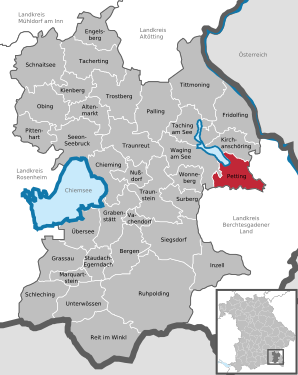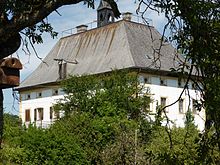Petting (community)
| coat of arms | Germany map | |
|---|---|---|

|
Coordinates: 47 ° 55 ' N , 12 ° 49' E |
|
| Basic data | ||
| State : | Bavaria | |
| Administrative region : | Upper Bavaria | |
| County : | Traunstein | |
| Height : | 451 m above sea level NHN | |
| Area : | 29.93 km 2 | |
| Residents: | 2323 (Dec. 31, 2019) | |
| Population density : | 78 inhabitants per km 2 | |
| Postal code : | 83367 | |
| Area code : | 08686 | |
| License plate : | TS, LF | |
| Community key : | 09 1 89 135 | |
| Community structure: | 71 districts | |
| Address of the municipal administration: |
Hauptstrasse 34 83367 Petting |
|
| Website : | ||
| Mayor : | Karl Lanzinger ( CSU ) | |
| Location of the municipality of Petting in the Traunstein district | ||
Petting is a municipality in the Upper Bavarian district of Traunstein .
geography
location
Petting is on the south bank of the Waginger See in the Rupertiwinkel .
Community structure
The community has 71 districts:
history
Petting, built on an alluvial surface from the last Ice Age , is said to have been an island when large areas were still under water. The island was considered safe and protected and was already inhabited at that time.
According to traditional records, the name Petting means a place that is subject to the inflow and outflow of water.
The place is said to have had a church around 800, but it was destroyed by the Hungarians around 900. The castle of the nobles of Pettingen supposedly stood on the square of the church. This noble family goes back to the 6th century. It is assumed that the succeeding gentlemen took the name of the village as their own. It is also assumed that petting already existed at the time of the Romans and that it had the same name at that time.
The history of the Ringham district can be traced back even further in documents, which, according to the Salzburg property register of Bishop Arno, the so-called “Notitia Arnonis”, already existed in 788.
The place was first mentioned in 1048 as "Pettinga". In 1335 the parish of Petting is incorporated into the St. Zeno monastery in Reichenhall. Petting was the seat of a chairman of the Archbishopric of Salzburg and fell to Archduke Ferdinand of Tuscany during the secularization in 1803 , and to Austria in 1805, which Petting had to cede to the Kingdom of Bavaria in 1810 . Petting then became an independent political municipality through the municipal edict of 1818 .
On July 1, 1971, the municipality of Ringham joined the municipality of Petting, whose municipal administration had previously been housed in the Petting municipal office. In order to avoid incorporation in the course of the Bavarian regional reform , Petting became an administrative association with Waging a. See , Taching and Wonneberg . After intensive efforts, Petting was able to leave the administrative community of Waging am See on January 1, 1986 .
| Population development | ||||||||||||||
|---|---|---|---|---|---|---|---|---|---|---|---|---|---|---|
| year | 1840 | 1900 | 1950 | 1961 | 1970 | 1987 | 1991 | 1995 | 2000 | 2005 | 2010 | 2015 | 2017 | |
| Residents | 1058 | 1178 | 2085 | 1606 | 1727 | 1891 | 1998 | 2138 | 2285 | 2338 | 2317 | 2321 | 2327 | |
Between 1988 and 2018 the municipality grew from 1,918 to 2,321 by 403 inhabitants or 21%.
politics
City council and mayor
The council consists of 14 councilors. After the local elections on March 15, 2020 , the seats will be distributed as follows:
- Free voter community : 7 seats (47.86%)
- CSU : 5 seats (36.55%)
- Green list: 2 seats (15.59%).
The turnout was 72.22%.
The mayor is currently Karl Lanzinger (CSU), who was elected in the local elections on March 2, 2008 with 92.5% approval (no opposing candidates). He was confirmed in office in March 2014, as well (with 86.4% of the votes) on March 15, 2020.
Community finances
In 2009 the municipal tax revenue amounted to € 1,132 million, of which € 288,000 (net) was business tax revenue.
coat of arms
Description of coat of arms
Blazon : In blue under a silver wavy bar, two slanted silver fish.
Coat of arms history, coat of arms data and flag
Due to the historically very close connection to the Sankt Zeno monastery in Bad Reichenhall , two slanted silver fish are included in the municipal coat of arms as an image of the monastery coat of arms, two silver fish in the red field , which has been used since 1416 . A wavy bar, the symbol for water, serves as a reference to the Waginger See, which is adjacent to the municipality.
The official coat of arms has existed since 1977.
The city's flags are blue-white-blue .
Attractions
natural beauties
Buildings
Seehaus Castle on the Weidsee
Seehaus Castle with its late Gothic house chapel is located directly on the idyllic Weidsee, surrounded by a wide belt of reeds, in the middle of the Weidsee landscape protection area.
Originally, Seehaus was a castle in the Middle Ages that was owned by the Counts of Thann, which was transferred to Archbishop Rudolf von Salzburg around 1280 . The castle was of great importance for the Archbishopric of Salzburg as a guard post on the medieval "Untere Salzstrasse", which went via Waging and Altenmarkt to Wasserburg and on to Munich be charged with tolls, which were of great importance for the archbishopric.
In 1479 the cost office and patronage court was moved from Petting to Seehaus, the latter was repealed in 1804. Towards the end of the 15th century, the castle was converted into a small castle, which became a popular summer residence for the Salzburg archbishops.
Later in 1600 the then ruling Archbishop Wolf Dietrich von Raitenau renewed the main building and transferred Seehaus Castle to his secret wife Salome Alt . After 1614 the castle returned to the possession of the Salzburg cathedral chapter .
Now the castle is privately owned and can therefore not be visited. Together with the lake, however, it offers a wonderful view.
Churches
The originally late Gothic church with its partly Romanesque tower and net vault is dedicated to John the Baptist. It was first mentioned at the turn of the 15th century. The first Gothic furnishings have disappeared; only three statues of the later Baroque furnishings remain today: St. Rupertus with the salt barrel, St. Virgilius with the Salzburg Cathedral, and St. Maria. In the 19th century the church was furnished in a neo-Gothic style.
Petting's side churches are located in Kirchhof and Kirchberg as well as in Reichersdorf , which, according to the current house name of the associated estate, must have served as a parsonage in the past. Kirchberg, a supposedly Romanesque church with a large cemetery, which is mentioned in old documents as a former parish church, was located on a Roman road and existed as early as the 7th century. During the Hungarian invasion around 900 it is said to have served as a refuge for the Bishop of Salzburg. Today's branch church of the Assumption of Mary in Kirchhof is a late Gothic hall church from the 15th century.
Economy and Infrastructure
Economy and Agriculture
In 2017 there were 372 jobs subject to social security contributions in the municipality. Of the resident population, 930 people were in an employment relationship subject to compulsory insurance. This means that the number of out-commuters was 558 more than that of in-commuters. 20 residents were unemployed. In 2016 there were 77 farms.
A regionally well-known brewery is the Schönram private country brewery founded by the farmer Jakob Köllerer in 1780 .
tourism
Petting, located near the Alps and Salzburg , is a destination mostly for German tourists, especially in the summer months. In 2017, the official statistics recorded a total of 17,928 overnight stays, 16,982 of which were from Germany and 946 from abroad.
education
In 2018 there were the following institutions:
- In the kindergarten with 87 approved places, 92 children were cared for by 14 people.
- In the primary school, 75 students are taught by four teachers in four classes.
societies
The place is characterized by numerous clubs such as a sports club, shooting club, traditional costume club, fishing club, music club, sailing club, in which youth work usually plays a very important role.
Soil monuments
See: List of ground monuments in Petting
Others
In the 1999 book Silentium by Wolf Haas (as well as in the 2004 film of the same name by Wolfgang Murnberger ) a common thread of the story is that detective Brenner finds a note “Petting 69” and asks various people about its possible meaning whose association is always petting as a sexual practice and provokes piqued reactions. In the end he finds out that the note represents an address (in reality, it does not exist in the recorded form) and goes to it to find out that sexual services are being performed in the house for the main actors of Salzburg opera productions.
Web links
- Homepage of the community of Petting
- Entry on the coat of arms of Petting (municipality) in the database of the House of Bavarian History
Individual evidence
- ↑ "Data 2" sheet, Statistical Report A1200C 202041 Population of the municipalities, districts and administrative districts 1st quarter 2020 (population based on the 2011 census) ( help ).
- ↑ http://www.bayerische-landesbibliothek-online.de/orte/ortssuche_action.html ? Anzeige=voll&modus=automat&tempus=+20111108/212654&attr=OBJ&val= 563
- ^ Wilhelm Volkert (ed.): Handbook of Bavarian offices, communities and courts 1799–1980 . CH Beck, Munich 1983, ISBN 3-406-09669-7 , p. 510 .
- ↑ a b c d House of Bavarian History - Bavaria's municipalities. Retrieved August 18, 2019 .





